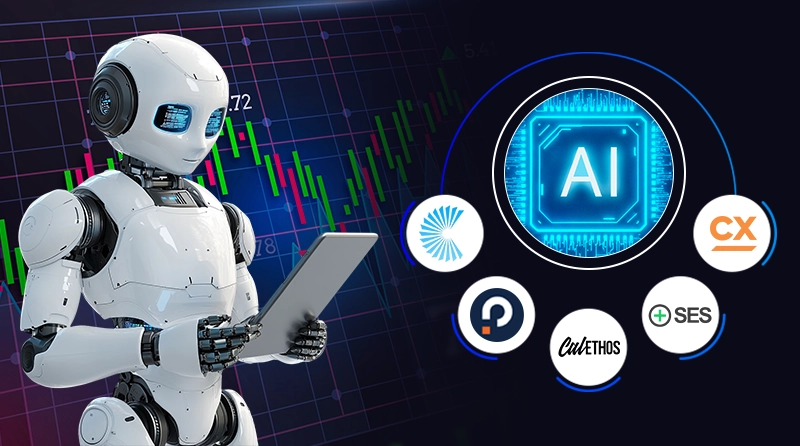What is Responsible AI? Certification, Best Practices, Use Cases & Training in 2025

Consider a scenario where artificial intelligence superficially makes all the important decisions related to your healthcare, financial management, and job prospects, without any oversight, transparency, or accountability. Considering the AI systems already in place in almost every industry, the real question is not if AI will change our lives but if those changes will be fair, safe, and compatible with human values.
Responsible AI has shifted from an up-in-the-air concept to a pressing business and ethical necessity. But what does it entail to develop and deploy AI responsibly?
Consider these eye-opening statistics:
- Three-quarters of CEOs believe they would be replaced within two years without significant AI-driven changes to their organizations, thus underscoring the strategic importance of responsible AI policies.
- The global market for responsible AI tools and services is projected to be $47.16 billion by 2034, growing at a CAGR of 48.4%, which signifies strong investments toward effective AI solutions.
- The artificial intelligence governance market is expected to grow from $6.58 billion in 2025 to $36.41 billion by 2034, thereby exhibiting a CAGR of 22.52%, as clearly indicative of the rising demand for effective AI governance systems.
As AI technologies increasingly underpin mission-critical applications, a holistic framework for responsible development cónceptually crosses the line from being an ethical consideration to a business imperative. This article examines the tenets, methodologies, certifications, and practical instances of responsible artificial intelligence in 2025.
What is Responsible AI?
Responsible AI is the design, development, and deployment of artificial intelligence systems that are ethical, open, accountable, and in harmony with human values as well as societal norms. It therefore welcomes a thorough approach, including ideas, techniques, and tools, assuring the intended effect of AI systems while reversing possible damages.
Moreover, responsible AI understands that the use of significant power comes with a great responsibility regarding the consequences that AI technologies could have on people, communities, and society at large. It means inquiries such as “Can we build this?” but more “Should we build this?” and “How can we make sure that this technology has a positive effect on human beings?”
The idea goes beyond simple technical issues to encompass:
- Proactive risk and harm detection and reduction
- Guaranteeing equity and stopping discrimination among several demographic groups
- Keeping AI systems under human supervision and control
- Protecting data security and privacy
- Designing clear and understandable AI models
- Setting up systems of government for responsibility
Responsible AI offers the ethical guardrails required to enjoy the advantages of AI innovation as its applications grow more sophisticated and autonomous, safeguarding against its risks. It therefore promises to create useful, reliable, and good AI systems.
Pro Tip: Think of Responsible AI as something that should be woven across the whole lifetime of AI creation rather than a one-off checklist item to be finished.
Responsible AI: Key Principles and Best Practices
Let us understand the principles and best practices to be remembered when deploying AI.
Fairness and Non-Discrimination
Any responsible AI practice must include fairness as one of its fundamental principles. AI systems must deliver uniform results across different demographic groups without sustaining or increasing existing social biases.
| Approach to Fairness | Description | Impact |
| Diverse Training Data | The system has sufficient cases to reflect all impacted categories. | Greatly reduces representational bias |
| Routine Bias Auditing | The system finds and applies fixes to mitigate bias continuously in results. | Increases AI system’s capacity to identify fairness issues prior to deployment. |
| Equity Constraints | Mathematical limits in model training. | Helps close gaps among demographic groups. |
| Many Fairness Definitions | Relates to Contextual Fairness Metrics | Treats Multidimensional Concepts of Fairness Equally |
Transparency and Explainability
Systems with transparent AI functionality enable users to understand both their decision processes and operational mechanisms. The concept serves multiple essential purposes.
| Advantage | Description | Business Effect |
| Decision Comprehension | Users comprehend the rationale behind decisions. | 34% rise in user trust. |
| Error Identification | Finds unwarranted model behavior. | 47% faster solution time. |
| Trust Building | Increases public and stakeholder trust. | 29% increased adoption. |
| Regulatory Compliance | Meets international transparency requirements, including the EU AI Act. | 31% decrease in cost and regulatory burden. |
Accountability and Human OversightThe implementation of responsible AI demands both defined accountability structures and human monitoring systems. The following elements form effective accountability frameworks:
| Accountability Element | Implementation | Impact |
| Governance Structures | The deployment of ethical AI systems requires specific roles to be assigned for ethical deployment. | 36% fewer unresolved ethical issues |
| Human Control Mechanisms | Human override in high-impact decisions | The system requires human intervention for decisions that have major consequences in healthcare and legal and safety environments. |
| Escalation Pathways | The organization should establish response plans to address unexpected AI behavior. | 58% faster response time |
| Decision Documentation | The recording of decisions should occur throughout the model lifecycle. | The system requires this feature for both audit purposes and transparency needs. |
Privacy and Data ProtectionAI must follow privacy laws and respect people’s data rights throughout the entire system lifecycle.
| Privacy Element | Description | Impact |
| Cutting down on data | Only gather the data that the AI needs to work. | This makes it less likely that that data will be shared and gives users more trust in the system. |
| Ways to Hide Your Identity | Use to find ways to protect private data. | Allow AI to grow while protecting people’s privacy. |
| Handling consent | Give people clear, simple choices for giving informed consent. | Helps you follow global privacy laws like the CCPA and GDPR. |
| Storing Data Safely | Use a secure, encrypted infrastructure to store and process personal information. | This will make it less likely that data will be stolen and that the government will fine you. |
Robustness and safety
AI systems need to be designed to handle adversary threats and maintain effectiveness in diverse operational environments.
| Security Element | Implementation | Effect |
| Adversarial Testing | Testing the system under stress and with simulated attacks to identify vulnerabilities. | Increases security and reliability in actual environments. |
| Exercises for the Red Team | Use teams from within the organization or external groups to attempt AI models from an attacker’s perspective | Identifies threats early and enhances model security. |
| Fallback Mechanisms | Ensure that AI systems have some way of handling situations where they don’t know what to do. | Prevents the spread of failure in high-stakes situations. |
| Monitoring for Security | Establish real-time monitoring to detect anomalous behavior or drift in the model. | Identifies and mitigates threats in real-time. |
Accessibility and Inclusivity
An accountable AI must be deployed for a diverse user base and ensure equitable access to the benefits for all.
| Inclusiveness Element | Implementation | Impact |
| Inclusiveness as a core element | Engage a diverse range of people, and use design approaches that are empathetic. | This makes the product easier to use in much broader cultural and ability contexts. |
| Accessible Interfaces | Create interfaces compatible with assistive technologies, such as screen readers. | This makes AI much easier for people with disabilities to use. |
| Adaptation to language and culture | Development of models for adaptation to linguistic and cultural differences. | Reduces exclusion and increases relevance worldwide. |
| Equity Checks | Regularly check how the model performs across diverse groups. | Ensures that the AI systems do not have any harmful effects on any group of individuals. |
Let us now walk you through the best practices for AI development in 2025.
Responsible AI Development Practices in 2025
Organizations that lead the way in 2025 have implemented thorough responsible AI development methods that embed ethical principles across the entire artificial intelligence development process, from design to continuous monitoring:
| Phase | Responsible AI Practices |
| Design |
|
| Evolution |
|
| Testing |
|
| Deployment |
|
| Periodic ethical reviews |
|
The National Institute of Standards and Technology (NIST) stresses that lifecycle monitoring, red-teaming, and stakeholder feedback are critical components of AI risk mitigation.
Example frameworks from major tech companies
The leading tech industry companies have established major ethical frameworks for artificial intelligence practice.
- Google’s Responsible AI Practices: These practices outline seven core values, which include social benefit in addition to justice, safety, privacy, security, scientific excellence, and responsibility. The frameworks provide two main tools, which include Model Cards for transparency tools and the What-If Tool for users to analyze model behavior across different scenarios.
- Microsoft’s Responsible AI Standard: The Responsible AI Standard of Microsoft contains six core values, which include fairness, dependability, safety, privacy, security, inclusiveness, openness, and responsibility. Microsoft developed the Responsible AI Dashboard to help teams apply these concepts across all phases of AI development.
- IBM’s AI Ethics Board: The AI Ethics Scale of IBM allows its AI Ethics Board to oversee company-wide AI system deployment through ethical assessments of bias, explainability, and robustness.
Pro Tip: The development of responsible artificial intelligence frameworks requires specific customization based on particular use cases, industry standards, and environmental backgrounds.
Responsible AI Governance and Policy Principles
Governance of AI is to set up the required framework, process, and policy to make sure that AI systems can be held accountable for their responsible operation within organizations. By 2025, more developed frameworks of governance over AI would typically include:
- A diverse representation of technical and non-technical backgrounds on the AI ethics committee board
- Clear policies for AI risk management
- Documentation requirements for models and datasets
- Incident response protocols
- Regular auditing and assessment processes
At the policy level, several foundational principles have emerged that underpin responsible AI, as we outline below.
- Human-centered approach to AI: the aim is for AI to enhance human capabilities and recognize human rights.
- Societal well-being: AI should benefit humanity and support fundamental rights
- Proportionality in risk management: Governance structures should be proportional to the risks identified in relation to AI applications.
- Multi-stakeholder collaboration: As far as policy development is concerned, the aspect of letting a wide variety of stakeholders participate in the process of policy development, including civil society, cannot be overemphasized
- International cooperation: Cross-border alignment on standards and regulations
NIST’s AI Risk Management Framework is yet another resource for organizations seeking to formulate responsible policies regarding artificial intelligence. The framework supplies a methodological process for the risk identification, assessment, and mitigation pertaining to responsible AI systems and policies.
Pro tip: A governance model can indeed be developed on a risk basis, that is, the oversight intensity increases with the risk involved in using each AI application. This would provide suitable safeguards while avoiding over-bureaucratization in low-risk applications.
Moreover, you may get a responsible AI certification, demonstrating your commitment to deploying ethical AI systems. Let us look at this certification next.
Read Also: AI in Healthcare
Responsible AI Certification & Training: Building Ethical AI Teams
What is Responsible AI Certification, and Who Needs It
Responsible AI certification initiatives guarantee that people and companies possess the necessary knowledge and tools to create and run AI systems ethically. Such certifications are essential for:
- Data scientists and ML engineers are directly engaged in developing artificial intelligence
- Product managers in charge of AI-enabled goods
- Executives deciding strategically on AI implementation
- Risk management and compliance experts
- Companies wanting to show their dedication to ethical artificial intelligence
A 2025 study by Accenture and Stanford University found that 49% of C-suite executives polled believe that responsible artificial intelligence is a major driver of income expansion connected to artificial intelligence for their companies. Only 14% have implemented responsible artificial intelligence; none have completely run responsible artificial intelligence initiatives throughout their companies.
Are you desirous of obtaining a responsible AI certification? You can get one from the institutes in the following section.
Trusted Certification Providers
The following certifying bodies, which are now well-known, provide honorable, responsible AI certifications:
- NIST (National Institute of Standards and Technology): The AI Risk Management Framework gets efficient implementation inside companies through the certification program provided by NIST.
- IEEE (Institute of Electrical and Electronics Engineers): The Ethically Aligned Design certification program by IEEE addresses technical and ethical elements of AI development.
- IBM: IBM’s AI Ethics Certification has established itself as an industry standard because it has certified more than 175,000 professionals worldwide by 2025. The program focuses on artificial intelligence system explainability, fairness, and transparency as well as robustness.
- Responsible AI Institute: The Responsible AI Institute offers specific certification tracks for high-risk sectors, including healthcare and finance, which provide role-based certifications for professionals, auditors, and executives.
In addition to building trust through the above certifications, you must also build teams that can develop ethical AI. The next section discusses the best programs to help train developers and data scientists.
Responsible AI Training Programs for Developers and Data Scientists
Several complete training courses are provided to help your team develop ethical AI.
Google’s Responsible AI Practices
AI system development and execution become possible through fairness, interpretability, inclusiveness, privacy, safety, and accountability standards taught in this course.
The team will discover:
- The process of developing platforms that include inclusive data collection methods
- Methods to verify transparency alongside bias reduction in systems
- Google implements ethical decision-making systems throughout its organization
Format: Free, self-paced, with case studies and essays.
Perfect for: The course aims at ML engineers, data scientists, and product designers.
Microsoft Learn’s Responsible AI
The Microsoft Learn platform delivers training about responsible artificial intelligence. This training program focuses on teaching students how to implement Microsoft’s ethical AI standard alongside tools for ethical artificial intelligence applications.
The team will discover:
- Using tools like Fairlearn and InterpretML, fair and comprehensible machine learning models.
- The process of aligning ethical values with development plans.
- Azure AI client case studies
Format: Interactive module, practical workshops.
The course is designed specifically for Microsoft Azure data scientists and AI control experts.
IBM AI Engineering Professional Certification
The training program focuses on the hands-on development of AI systems through ethical design principles combined with responsible usage methods.
The team will discover:
- Fairness and power in ML pipelines
- Techniques of explainability, including LIME and SHAP
- Practical uses in HR, healthcare, and finance
Format: 6-course program including tests and projects.
The course is ideal for engineers and data scientists at an intermediate level.
Fast.ai Ethics in AI Module
This course emphasizes ethics in pragmatic deep learning training.
The team will discover:
- Bias in datasets and algorithms
- The historical and sociological origins of algorithmic harm
- Creating fair and effective AI models
Format: Fast.ai‘s main deep learning course.
The training program suits developers who want to grasp ethical AI education and fair methods.
Responsible Artificial Intelligence Practitioner Certification (RAI)
The certification program trains RAI framework practitioners for practical AI implementation through role-based training.
The team will discover:
- Risk management in line with NIST AI RMF
- Audit-ready documentation techniques
- High-risk industries’ responsible artificial intelligence implementation
Format: Online training in role-based modules—developer, auditor, executive.
The certification targets AI professionals who work within healthcare and financial sectors and public institutions.
Pro tip: The most successful training courses combine theoretical understanding with practical practice. Choose classes that provide practical experience with ethical problem-solving in real-world applications.
On that note, let us look at how responsible AI is used in the real world across various industries.
Real-World Applications of Responsible AI Use
Use cases in healthcare, finance, HR, and marketing
The applied movement of responsible AI operates across multiple sectors to enhance outcomes and reduce bias while building public trust. The healthcare, finance, human resources (HR), and marketing sectors have produced major case studies in 2025.
Healthcare: Personalized Cancer Treatment at MSKCC
Memorial Sloan Kettering Cancer Center joined forces with Mount Sinai to deploy the AI tool SCORPIO, which helps doctors determine optimal immunotherapy candidates among cancer patients. The system includes built-in fairness checks, which enable oncologists to understand model logic while providing accountability in model logic.
The SCORPIO tool enables medical professionals to sort immune checkpoint inhibitor responses among patients while maintaining unbiased treatment selection precision.
Finance: Responsible Lending at Goldman Sachs
The lending operations of Goldman Sachs maintain fairness-aware algorithms throughout their lending processes. The models undergo periodic bias audits while providing explainable characteristics, demonstrating both transparency and regulatory compliance.
The established practices enable credit access and ensure adherence to performance standards.
Human Resources: Ethical Hiring at Unilever
Unilever has implemented an AI-based hiring platform that removes personal information from candidates and performs bias assessment tests while using video evaluation and gamified assessment methods.
The system enabled faster hiring in 2025 while creating substantial workforce diversity improvements.
Marketing: Transparent Targeting at Adobe
Through its responsible marketing platform, Adobe gives users complete visibility into their targeted advertisement reasons while enabling detailed privacy management capabilities.
The Adobe Digital Trends Report from 2025 shows that 88% of consumers believe safe and ethical AI use matters, and 60% consider it essential for building brand authenticity.
Next, let us discuss integrating the principles of responsible AI into various phases of product development.
How companies embed responsible AI into the product lifecycle
Organizations that lead implement responsible AI principles across their entire product development process.
- Strategy phase: The organization starts by performing ethical impact assessments to determine which AI use cases will be selected during the strategy phase.
- Design phase: During the design phase, organizations apply inclusive design approaches while establishing ethical standards for their work.
- Development phase: The development phase requires organizations to build fairness metrics together with privacy protections and transparency features.
- Testing phase: The testing phase requires thorough bias audits and adversarial testing procedures.
- Deployment phase: The deployment phase requires organizations to establish monitoring systems and feedback channels.
- Operations phase: The operations phase requires organizations to perform regular audits and conduct performance reviews.
This integrated method ensures that ethical considerations become fundamental components of the development process instead of optional add-ons.
Metrics and KPIs to track responsible AI use
Leading ethical AI companies track various dimensional metrics:
- Fairness criteria: Statistical parity, equal opportunity, various impact ratios
- Openness indicators: User knowledge degrees, transparency scores
- Privacy policies: Data minimization rates, percentages of consent fulfillment
- Human monitoring metrics: Rates of intervention, accuracy of overrides
- Stakeholder confidence indicators: Legal compliance percentages, user trust ratings
According to a Microsoft-commissioned 2025 IDC whitepaper, over 75% of businesses employing responsible artificial intelligence reported improvements in data privacy, customer experience, confident business decisions, and strengthened brand reputation and trust.
These findings suggest that while specific percentage increases in user happiness and declines in regulatory concerns may vary, the application of responsible artificial intelligence methods is related to clear benefits in key areas relevant to business performance.
Pro Tip: A balanced scorecard system should be used for responsible AI implementation, which combines technical metrics (such as fairness measures) with human-centered metrics (such as user trust and comprehension).
While responsible AI implementation is beneficial, it may also be challenging. Let us understand the challenges you may experience while implementing it.
Challenges in Implementing Responsible AI
While consciousness is growing, several challenges can be faced in implementing ethical artificial intelligence, such as the following.
1. Technical Complexity: Performance vs. Explainability
Generally, the high-performing machine learning models are less transparent, thereby complicating the quest for accurate and explainable models. Improving explainability requires a developer who will make trade-offs in performance between built models based on research outcomes.
2. Organizational Silos: Ethical and Engineering Disconnection
Organizational silos are a barrier to adherence to ethical standards because organizations have different operational units. A Deloitte survey reveals that over half of the artificial intelligence policies do not include a timeframe for AI governance goals or an ethical criterion related to principles and guidelines for AI.
3. Changing Laws: Negotiating a Difficult Terrain
The rapid evolution of regulatory frameworks makes it increasingly difficult for organizations to ensure compliance.
4. Limited Resources: Issues for Smaller Businesses
Small enterprises cannot formulate detailed guiding policies on responsible artificial intelligence because they are resource-constrained. With only 1% of companies having reached this milestone, the McKinsey & Company 2025 report further explains that resource constraints are what prevent businesses from attaining AI maturity.
5. Measurement Issues: Tracking and Defining Ethical Metrics
The assessment of ethical standards and justice faces ongoing methodological obstacles. The Partnership on AI advocates for the creation of effective monitoring tools to track progress toward practical, ethical artificial intelligence objectives.
The implementation of these problems requires several basic methods to solve them, even though they present difficulties.
Strategies to Overcome Challenges in Responsible AI Implementation
Organizations can address these challenges through:
- Cross-functional teams: The implementation of responsible AI practices requires technical experts to work with ethical experts as part of cross-functional teams.
- Incremental approach: Organizations should adopt modular approaches to develop responsible AI practices through incremental implementation.
- Collaboration: Participating in consortia enables organizations to exchange best practices and tools with other members.
- Open-source tools: Organizations should utilize open-source tools because they help address their limited resources.
- Specific metrics: Organizations must create specific metrics that align with their organizational values to properly assess their ethical AI targets. The focused approach allows organizations to distribute their resources more effectively.
Pro Tip: Perform a maturity assessment as your first step because it will identify your organization’s specific barriers and opportunities for implementing responsible AI practices. Organizations benefit from this method to make better decisions about resource allocation.
Looking for a blueprint to develop responsible AI? Then, below is a complete plan of action for its development.
Roadmap to Responsible AI Development
Responsible AI lifecycle: from design to deployment
The definition of responsible development spans the entire AI lifecycle process:
Problem formulation:
- Assess ethical implications and stakeholder impacts
- Conduct value-sensitive design workshops
- Ensure diverse stakeholder participation to detect potential issues.
- Establish ethical boundaries and success criteria
Data collection and preparation:
- Perform consent management alongside data governance implementation.
- An evaluation of the dataset representativeness should be performed to detect current gaps in the data.
- Ensure document data provenance and limitations
Model development:
- Select algorithms that provide appropriate transparency features.
- Ensure the training process includes fairness constraints for proper implementation.
- Select models while evaluating the ethical implications that result from each choice.
Testing and validation:
- Execute fairness audits to check demographic groups for potential biases during testing.
- Conduct adversarial testing to expose its potential weaknesses.
- Evaluate the system’s explainability features, which should work for various stakeholder groups.
Deployment and monitoring:
- Deploy systems through graduated deployment strategies.
- Ensure ongoing monitoring to identify both data drift and disparate treatment effects.
- Make sure to have channels for users and affected individuals’ feedback.
Are there any tools to help you with responsible AI implementation? If this is what you wish to ask, the following section answers your question.
Tools to Assist with Responsible AI Practices
A tool ecosystem has emerged to support ethical AI considerations.
Fairlearn
Fairlearn is the Microsoft toolkit for helping organizations gauge and improve fairness in machine learning models. Organizations using Fairlearn experience 43% less algorithmic bias in protected attributes.
Fairness 360
IBM’s AI Fairness 360 provides an exhaustive, comprehensive toolkit for identifying and alleviating bias in machine learning models during the entire lifecycle from development to deployment. The toolkit offers over 70 fairness metrics and 11 bias mitigation algorithms to its users.
LIME and SHAP
The explainability tools LIME and SHAP help data scientists understand and clarify the decisions of a model. Research shows that users trust models explained by these tools 37% more than models without explanation.
Model Cards Toolkit
Google’s Model Cards Toolkit provides a standardized framework for model documentation, thereby increasing transparency and allowing better deployment decisions.
InterpreML Toolkit
The Microsoft InterpretML toolkit enables data scientists to produce global and local explanations for black-box models, thereby aiding companies in complying with regulations and fostering trust among users.
Pro Tip: Begin with the use of open-source tools to help you develop organizational capabilities so that you can turn to commercial solutions later. This approach helps teams to gradually acquire skills starting from almost nothing.
Internal Governance Checklist for Responsible AI Use
Companies creating a governance framework for artificial intelligence use should establish:
- Clear objectives
- Ethical guidelines
- Accountability measures
- Transparency protocols
- Stakeholder engagement
- Risk assessment strategies
- Compliance standards
- Continuous monitoring
- Adaptability mechanisms
- Training and education initiatives
Future Trends in Responsible AI
Such artificial intelligence will keep evolving, but several significant trends will shape the future of responsible AI. The following are some examples of these future trends.
- Federated learning will become the de facto approach for building privacy-preserving artificial intelligence, allowing organizations to train models on distributed datasets without ever centralizing sensitive information.
- Algorithmic impact assessments will be required for high-risk applications, much like environmental impact assessments are today.
- Collective governance models, featuring multiple stakeholders, will likely become the dominant governance model for overseeing high-impact AI technologies.
- Real-time ethical monitoring systems would track AI behavior after deployment and intervene immediately if the systems acted unpredictably.
- Responsible AI-as-a-service platforms would democratize access to ethical AI tools, empowering smaller companies to put in place significant safeguards without relying on large internal expertise.
Pro Tip: Try developing scenario planning capabilities so that you can effectively anticipate and also prepare for the ethical challenges that will likely emerge with the continued rapid development of AI capabilities.
Conclusion
Businesses and society require Responsible AI because artificial intelligence now stands as an absolute necessity for organizations. Organizations that integrate ethical considerations throughout their AI lifecycle will succeed better than those that do not in building trust while managing risk and sustaining innovation.
Every member of the organization, including executive leaders, data scientists, and frontline employees must function as responsible artificial intelligence stewards. Organizations must demonstrate genuine dedication to diverse perspectives from within their corporate structure and outside it, even when ethical priorities surpass immediate performance targets.
Organizations across all sizes now have better access to frameworks, tools, and professional expertise, which enables them to implement responsible AI practice. The main challenge now is for companies to implement responsible AI operations at a rapid pace instead of spending time debating its necessity.
The future development of artificial intelligence guarantees that organizations that pursue responsible innovation will obtain both AI transformation capabilities and sustained market success. Organizations that achieve success will recognize that responsible AI operates through business requirements instead of ethical duties.
FAQ
What are responsible AI practices?
The development and deployment of artificial intelligence systems through responsible AI practices ensures ethical and fair systems that are transparent and accountable. The practices for responsible AI include fairness assessments, explainability techniques, meaningful human oversight, privacy protection, and informed consent for data use through model documentation and clear governance structures. These practices aim to develop AI systems that benefit humanity while reducing potential harm.
How do I get a responsible AI certification?
The first step to getting responsible AI certification is to determine which certification matches your role and objectives. The main certification options for AI include NIST’s AI Risk Management Certification, IEEE’s Ethically Aligned Design Certification, IBM’s AI Ethics Certification, and role-specific certifications from the Responsible AI Institute.
The majority of certification programs need candidates to finish courses about ethical principles and technical methods for bias mitigation and explainability and governance frameworks, and relevant regulations.
The certification process includes passing an examination and practical application through projects or case studies for advanced credentials. The field’s evolution requires most programs to maintain certification through ongoing education.
What is the difference between responsible AI governance and policy?
Organizations use responsible AI governance to create internal systems that ensure their AI systems develop and deploy ethically. Organizations must establish ethics committees and review processes, documentation requirements, and monitoring systems to achieve responsible AI governance.
Organizations use responsible AI policies to establish formal rules and guidelines that define their ethical approach to AI implementation. The policies establish guidelines for acceptable use cases and require fairness measures, privacy protections, transparency requirements, and accountability mechanisms.
Governance focuses on ethical oversight operations through structural processes, while policy defines the ethical standards that organizations must follow through rules and guidelines. The implementation of responsible AI requires both effective governance structures and clear policies to function properly.




![10 Best AI Note-Taking Apps [ 2025 Note Taker Tools]](https://awesmai.com/wp-content/uploads/2025/07/Best-AI-Note-Taking-Apps.webp)










